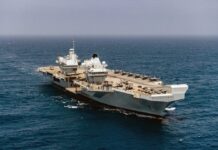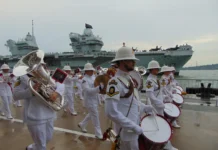
Intrepid’s Fighting Squadron 18. By Mike Fink. Naval Institute Press, Annapolis, 2024 ISBN 978-1-68247-321-4.
Reviewed by David Hobbs
Mike Fink is a historian at the Intrepid Air and Space Museum, based on the preserved aircraft carrier berthed at Pier 86, close to 12th Avenue and West 46th Street New York. He became fascinated with the history of VF-18 Squadron, which was embarked in the carrier during 1944, and spent six years researching its history.
During this period he studied a wealth of archive material, interviewed those squadron pilots who were still alive and contacted the families of those who were not, many of whom were only too pleased to contribute their stories, letters and photographs. The result is an excellent and very readable book that takes us back into VF-18 Squadron during 1944 and describes its outstanding period of operations in the Pacific as part of Intrepid’s Air Group 18. The descriptions of individuals are written with care and clarity and on finishing the book I almost felt that I knew some of them personally.
The book follows a logical sequence beginning with an introduction to some of the unit’ s characters as they joined up and went through flight training before giving a detailed account of strike fighter operations off Formosa, now Taiwan, and during the campaign to recover the Philippines. Air-to-air combat, bombing sorties against land targets and attacks on a number of ships including the Japanese battleship Musashi in the Sibuyan Sea are all described in detail. The result gives a vivid impression of how a US Naval fighter squadron equipped with Grumman F6F-5 Hellcats was manned, trained, assembled and how it was used in combat. It brings a human dimension to the historiography of the Pacific war in its later stages, not least the efforts that were made to counter the threat of Kamikaze attacks. As the achievements of the USN Fast Carrier Task Force in the Pacific during 1944/45 pass beyond living memory it is important to capture the stories of individuals so that their achievements can be known in their proper context to later generations. Mike Fink has done a particularly good job of doing so and is to be congratulated for the empathy he has shown. He takes us beyond the dates and statistics of the largest scale of naval operations the world had ever known, allowing readers to understand how the tension of continuous flying in the most dangerous circumstances affected the squadron’s pilots in different ways. He manages to stimulate our imagination by absorbing us into the squadron’s activities with a vivid portrayal of life in an Essex class aircraft carrier in action. His description of the casualties caused by Kamikaze hits are moving.
By the end of the war in 1945 the US Navy and Marine Corps had over 6,000 fighter pilots serving in operational squadrons and so VF-18, with roughly 50 pilots during the period in question, was only a small fraction of the total. It was, however, an outstanding example and one of its pilots, Lieutenant Cecil ‘Speedball’ Harris USNR was the second highest-scoring Navy fighter pilot of the war. He and his wingman Ensign Arthur ‘Moe’ Mollenhaur USNR, the squadron’s youngest pilot, shot down 9 enemy aircraft on 13 October 1944, the first day of strikes against Formosa. Harris was eventually credited with shooting down 24 Japanese aircraft, 16 of them during a four day period for which he was awarded the Navy Cross. VF-18’s Pacific deployment ended when the ship was hit and damaged by Kamikaze attacks on 25 November 1944 during which 69 officers and men were killed. During the 81 days the ship was in action VF-18 shot down 170 enemy aircraft earning it the nickname ‘Two-a-Day 18’.
The book is well illustrated with 30 well-chosen black and white photographs and 7 excellent maps which show where the ship operated and a succession of strike operations carried out. I found it a fascinating read and recommend it to anyone who wants to find out more about how the USN Fast Carrier Task Force of 1944/45 operated.



